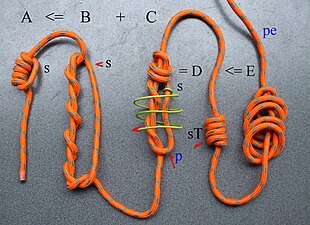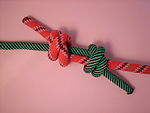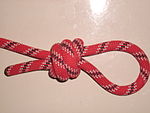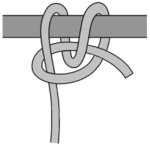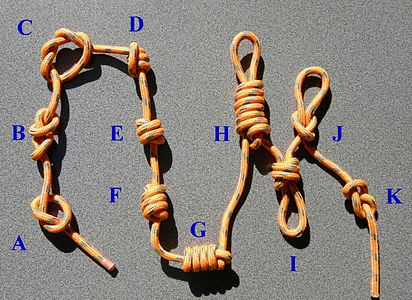Multiple overhand knot
| Multiple overhand knot | |
|---|---|

|
|
| Type | stopper |
| application | Stopper knots , throw knots , decorative knots |
| Ashley No. | 517 (double overhand knot: 516) |
| English | multiple overhand knot, coil knot (double overhand knot, small coil knot) |
| List of nodes | |
The multiple overhand knot is a variant of the (simple) overhand knot . Depending on the number of knot turns, it is also known as a double overhand knot , triple overhand knot , quadruple overhand knot , etc.
The knot is very material-intensive, even as a double overhand knot it needs about 20 times the rope diameter. If it is tightly closed, it can hardly be released again.
application
- The multiple overhand knot has several uses. Tightened at the end of the rope, to be knotted, it prevents the rope from fraying; however, a whipping stick holds up significantly better in the long term . As a stopper knot , the multiple overhand knot (especially the double overhand knot) can prevent a rope from slipping through an eyelet ("rushing out"), or it can improve the grip of the rope. In addition, the knot can be used as a light throwing knot .
- Regularly tied into the rope several times, it serves as a replacement for a rope ladder . Alternatively, wooden rungs can be drilled through at the end and the rope pulled through and knotted under the rung.
- Looped around the opening of a sack as an eye , it can be closed with it and secured with a simple overhand knot . Dito, o with two windings and a rod. Ä. Is linked to the Strangleknot (constrictor knot) to ABOK # 1239
- The Franciscans use several triple overhand knots tied one behind the other on their cingulate of the monk's costume . This triple overhand knot is specifically referred to as a Franciscan knot or "Capuchin knot ".
- Military award for armpit lacing , engl. " Honor Cord ", French " Fourragère ".
Knot
Tying the Franciscan knot (tying version I)
The triple overhand knot starts with a simple overhand knot and gets two additional windings. A threefold or even larger overhand knot must be brought into the form with this tying method. It is more decorative than practical. See also the following section: Knotting version II
First you tie an overhand knot by twisting the end around your own standing part .
Tying the Franciscan knot (tying version II)
You start as above and wind the loose end of a rope three times around your own standing part
Tighten the knot on both ropes (ends)
Tying the Franciscan knot (tying version III)
For more than two or three overhand knots, the above method must be used during the tying process in order to be able to lay the rope in the shape of the finished knot. This can be complicated and time consuming with many turns.
Because of this, it is easier to tie the multiple overhand knot as with the Franciscan knot.
At the Franciscan knot only the windings can be seen. The desired number of turns / turns is wrapped around the standing part and at the end the end is put through all turns (from the last to the first turn) and pulled tight. The rope exit is absolutely parallel. The result is an "X – fold" overhand knot that lays in the desired shape without having an outer section of rope. However, it can happen that the number of turns is reduced by the contraction of numerous turns. For example, only 10 turns can be retained out of 11 (due to deformation when contracted).
Three different types of construction
A = Franciscan knot (knots are parallel in a row)
B = Throw knot with 3, 4, and 5- turn trips
C = Multiple overhand knot (according to Quipu the number 3, 4, 5 ) - Inclined knot exit -Various military awards, also as " Honor Cord " with 4 windings
Tying the triple overhand knot according to the Quipu knot script (knot version IV)
The Incas used the simplicity of the knot to create an exact number with the knot script " Quipu " and to fix it permanently in a strand. In addition to the Franciscan knot and the eight knot, they also used a version of the triple overhand knot, in which the turns turn around a piece of rope / part and another section of rope runs around the outside of the turns . The end is not completely parallel, but is at a slight angle from the "node exit". This is also a multiple overhand knot, but it was tied differently.
You start as with I and II and wrap the loose end of a rope around your own standing part
Tighten the knot on both ropes (ends)
Comparison of knot version I (II), III and IV
Description of the picture:
The multiple overhand knot A (here 5-fold) is created by making B when it is pulled together after knotting version I and shaped according to the knot script Quipu.
If, on the other hand, 5 windings around the other strands are started at B at point s , C continues in the yellow "winding direction", D results with the windings / turns after sT .
However, this can be created more quickly and easily according to the knotting version II .
In the case of strong thaws, the point p can be twisted; the point is then pulled out towards pe .
Alternative knots for the same purpose
- Stopper knots are larger and stronger.
- There are heavier knots .
- The rope ladder knot is also suitable for rope ladders .
Modifications
Two lace knots around the other rope result in the double spar stitch
Here one end of the rope is fed back through the lace knot and results in the cave knot with 2 windings
Here one end of the rope is led back through a triple overhand knot and results in the two-strand ribbon knot
Anglers use the same technique to “knot” their nails to attach their hooks to fishing line. The “ nail ” only serves as a placeholder / aid to form a tunnel, which is used for easier insertion of the fishing line. - A match or, in the case of larger rope diameters, a similar rod achieves the same purpose. With a small number of windings, a finger around which the windings are wrapped is sufficient.
The surgeon's knot is secured with a simple overhand knot
Roringstek . The double overhand knot is basically the basis of this knot. If the rod is pulled off, you can see that it is a double overhand knot.
- Choice of different overhand knots
A: The normal overhand knot as the starting knot (here, knotted to the right)
B: Two normal overhand knots next to each other
C: Multiple overhand knot (knit inwards three times)
D: corresponds to C: as a contracted knot; (The distinctive distinguishing feature is the "connecting piece" on the knot, between the first and last winding, which lies outside on the windings) see Quipu knot
E: Franciscan knot = triple overhand knot (put through 3 turns / windings) Rear view
F: Quadruple overhand knot (put through 4 turns / windings) here the rear view
See also
Individual evidence
- ↑ a b Willmore, Heidy, macramé, A Comprehensive Guide, Faber and Faber Ltd. 1979, ISBN 0-571-11310-9 (page 44 as a double overhand knot fig. 106, 107; as a multiple overhand knot see page 43 fig. 104)
- ↑ ABoK # 3834 " A knotted bathing ladder "
- ↑ Clifford W. Ashley, Jason Dalton: The Ashley Book of Knots . Edition Maritim Hamburg, 1999, ISBN 3-922117-37-6 , p. 297 .
- ↑ When Whipping (Engl.) Is used to produce a similar technique whippings used. The result is a whipping on a rope.























